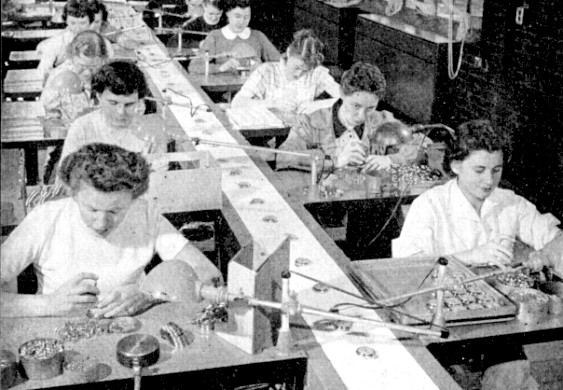
Production line in a clock and watch factory. Wages and working
conditions of Canadian workers are generally high and continually
improving. The 40-hour week is enjoyed by 7 out of 10 persons in manufacturing
employment and most of them are covered by pension and other welfare
plans. (1958)
Assembly line jobs, improving wages, and improving working conditions have unfortunately departed from Canada in recent decades. Assembly line work to create a complex, purely mechanical object such as a watch has also largely disappeared from Canada.
Through terrestrial or wireless networks, our computers and cellphones are probably accurate to within a second most of the time. It is difficult to imagine an era when the most precise time was made portable through a completely mechanical device. This was the 'railway grade watch'. Generally powered by the hand muscles of the crew member winding it, the watch had the additional virtue of being 'green' - rather than needing replacement batteries or recharging.
At specific railway division points - i.e. where crews changed - designated watch inspectors were responsible for maintaining the railway grade watches owned by all railway employees whose duties required them to have ready access to the correct time when on duty. Periodically each employee affected would leave their watch with the inspector for cleaning and regulation over a few days to ensure it was keeping 'good time' ... 'isochronism' in the ad below. The employees had to be able to show certification that their watches had been serviced and tested whenever this was demanded by authorities.
A few years ago, my spouse and I visited the old Dominion Observatory buildings in Ottawa - where standard time was determined celestially (before atomic clocks) and sent out across the railway networks via telegraph. I explained the historic, traditional process still used on the north shore of Lake Superior in 1977 to the young engineer guiding us around the buildings that weekend ...
Essentially, every day at 13hr, the operators at each station where a standard clock was maintained would tune in to CBC Radio and note the variance of the standard clock from the time signal. A sign at the clock would be changed to record the deviation from standard time, or the clock would be reset. From this standard in each yard office, crew members would verify the time they carried with them as they came on duty.
I explained to our guide that 'his' time signal, carried around with us in railway grade wrist watches, would ultimately run the whole railway in the event that there was a massive failure of the centralized traffic control system ... requiring the railway to revert to train order and timetable operation. That is, without any coloured light signals, track occupancy circuits to keep trains separated, and power switches operated by the dispatcher.
Assembly line jobs, improving wages, and improving working conditions have unfortunately departed from Canada in recent decades. Assembly line work to create a complex, purely mechanical object such as a watch has also largely disappeared from Canada.
Through terrestrial or wireless networks, our computers and cellphones are probably accurate to within a second most of the time. It is difficult to imagine an era when the most precise time was made portable through a completely mechanical device. This was the 'railway grade watch'. Generally powered by the hand muscles of the crew member winding it, the watch had the additional virtue of being 'green' - rather than needing replacement batteries or recharging.
At specific railway division points - i.e. where crews changed - designated watch inspectors were responsible for maintaining the railway grade watches owned by all railway employees whose duties required them to have ready access to the correct time when on duty. Periodically each employee affected would leave their watch with the inspector for cleaning and regulation over a few days to ensure it was keeping 'good time' ... 'isochronism' in the ad below. The employees had to be able to show certification that their watches had been serviced and tested whenever this was demanded by authorities.
A few years ago, my spouse and I visited the old Dominion Observatory buildings in Ottawa - where standard time was determined celestially (before atomic clocks) and sent out across the railway networks via telegraph. I explained the historic, traditional process still used on the north shore of Lake Superior in 1977 to the young engineer guiding us around the buildings that weekend ...
Essentially, every day at 13hr, the operators at each station where a standard clock was maintained would tune in to CBC Radio and note the variance of the standard clock from the time signal. A sign at the clock would be changed to record the deviation from standard time, or the clock would be reset. From this standard in each yard office, crew members would verify the time they carried with them as they came on duty.
I explained to our guide that 'his' time signal, carried around with us in railway grade wrist watches, would ultimately run the whole railway in the event that there was a massive failure of the centralized traffic control system ... requiring the railway to revert to train order and timetable operation. That is, without any coloured light signals, track occupancy circuits to keep trains separated, and power switches operated by the dispatcher.
Our Dominion Observatory guide then betrayed to me his identity ...
as a fellow traveller in the world of system-wonkery ...
"Always gotta have a backup system", he said.
as a fellow traveller in the world of system-wonkery ...
"Always gotta have a backup system", he said.
Right on, brother.
* * *
An ad from 1952 from the Canadian National Magazine - for employees.
Other brands advertised in other issues included
Ball ($64-82.50) Elgin ($97.50-105 gold filled case).
These were highly engineered, high quality mechanical products
which were essential for safe railway operation.
Other brands advertised in other issues included
Ball ($64-82.50) Elgin ($97.50-105 gold filled case).
These were highly engineered, high quality mechanical products
which were essential for safe railway operation.
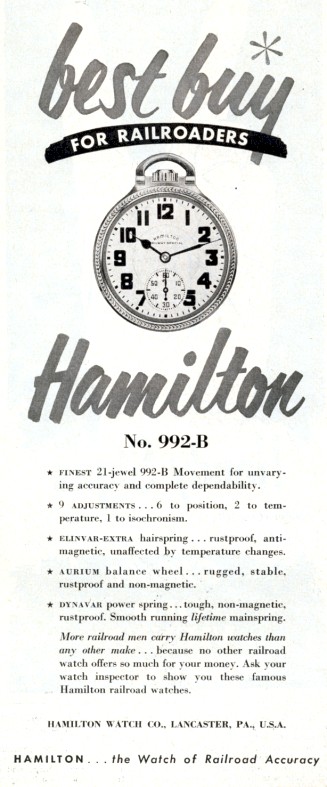
Central Railway Express Terminals
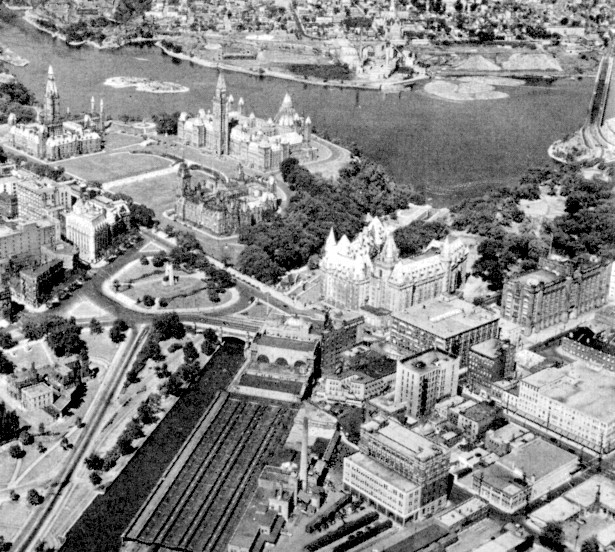
The business section of Ottawa, capital of Canada.
The Parliament Buildings over look the Ottawa River, across which lies the city of Hull, Que. (1951)
The Parliament Buildings over look the Ottawa River, across which lies the city of Hull, Que. (1951)
In the centre foreground you can see some of the old railway facilities of Ottawa.
The long dark passenger train platform shelters (the 'trainshed') protect passengers from the weather.
They lead to Union Station which has a tunnel connecting it with the Chateau Laurier Hotel.
Within the frame is Ottawa's post office, as well as the East Block of the Parliament Buildings.
I am fuzzy on proper details, but I believe British gold reserves were kept in a huge East Block safe during World War 2.
(In case Hitler invaded Britain, the gold was safe ... as well, Britain was buying American war goods aplenty)
Beyond the right photo margin is the Royal Canadian Mint - today limited to the production of collector coins.
Gold, money and mail all moved securely across Canada by express trains - through this transportation hub.
The pulp and paper facilities across the river in Hull (Gatineau)
are visible to the left of the Alexandra (railway, streetcar, road) Bridge.
Military Aviation Build-up

Canadian-built F-86 Sabre jets are a major element in the air defence
of the free world. They are in service with the Royal Canadian Air
Force in Europe, the Royal Air Force and the Air Forces of Greece,
Turkey, South Africa, Colombia and West Germany and saw action with the
United States Air Force over Korea. Late in 1956, West Germany placed
an order for 225 Sabres plus spare and ground handling equipment. The
order, which include 400 Orenda engines, is valued at $75,000,000. The
RCAF will train 360 German aircrew in Canada to man the aircraft. (1957)
The Sabre was designed by the
same company which built the legendary P-51 Mustang of World War 2.
These Sabres were built in Canada under licence before the days of
secret electronic weapons systems and software ... and secret
structural composites with stealth coatings.
The most powerful Sabres were the Mark 6, built by Canadair (Montreal) and powered with the Orenda engines built by Avro of Toronto. As the Cold War heated up in the 1950s, fast jet fighters were built in large numbers to protect Europe and North America from Soviet bombers carrying atomic bombs. Sophisticated avionics and air-to-air missiles (some with atomic warheads to destroy entire bomber formations) eventually led to fighter pilots attacking beyond their range of vision. However, pilots of early jet fighters such as the Sabre engaged each other using modified World War 2 and Korean War dogfighting techniques, visually targeting their machine guns or cannon in most cases.
Canada ended World War 2 with the 'fourth largest air force in the world'. In Canada, the ability to design (e.g. the Canuck and the Arrow) and build modern attack aircraft has disappeared, and very few countries today can still afford this expensive sport.
The most powerful Sabres were the Mark 6, built by Canadair (Montreal) and powered with the Orenda engines built by Avro of Toronto. As the Cold War heated up in the 1950s, fast jet fighters were built in large numbers to protect Europe and North America from Soviet bombers carrying atomic bombs. Sophisticated avionics and air-to-air missiles (some with atomic warheads to destroy entire bomber formations) eventually led to fighter pilots attacking beyond their range of vision. However, pilots of early jet fighters such as the Sabre engaged each other using modified World War 2 and Korean War dogfighting techniques, visually targeting their machine guns or cannon in most cases.
Canada ended World War 2 with the 'fourth largest air force in the world'. In Canada, the ability to design (e.g. the Canuck and the Arrow) and build modern attack aircraft has disappeared, and very few countries today can still afford this expensive sport.
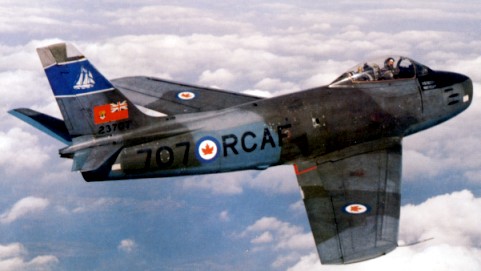
The Sabre jet of 434 (Bluenose) Squadron above - is probably a Mark 6 circa 1960 with a maximum speed of about 700 mph and a combat range of about 360 miles.
Mainly used as a dogfighter and bomber interceptor, this Sabre could reach 40,000 feet in about 6 minutes. Bluenose Squadron flew Sabres from 1952 to 1962.
Originally, 434 Squadron began as a heavy bomber
squadron during World War 2 - flying four-propeller Halifax and Lancaster
bombers. Disbanded after World War 2, 434 was reborn as a fighter squadron in 1952 to support Canada's commitment to provide twelve squadrons of these 'Swords' for NATO's
defence of Europe. Much of 434's time in Europe was spent at
Zweibrucken, in the French-occupied section of West Germany.
For practice, Canadian squadrons would often opportunistically 'bounce' each other and engage in mock dogfights. The weapons used were cameras. Once engaged, the tenacious fight continued until the loser waggled wings in capitulation, and allowed the victor to fly alongside in formation to verify identities. The victor would often display an obscene 'salute' before banking and flying away.
For practice, Canadian squadrons would often opportunistically 'bounce' each other and engage in mock dogfights. The weapons used were cameras. Once engaged, the tenacious fight continued until the loser waggled wings in capitulation, and allowed the victor to fly alongside in formation to verify identities. The victor would often display an obscene 'salute' before banking and flying away.
Canadian Branch Plants

The dieselization of Canada's railways has involved the gradual conversion of shops and servicing facilities
and the re-arrangement of work programs from steam to diesel maintenance. (1957)
Montreal Locomotive Works, being a Canadian subsidiary of American Locomotive Works (Alco) of Schenectady, New York,
built diesel locomotives for the Canadian market using Alco designs.
Prior to that, it had built Canadian steam locomotives following the persnickety design specifications
of the individual Canadian railways' steam motive power gurus.
Many were really good engines ... and some were poor-steamin', rough ridin', hard to maintain, duds.
Like the Sabre jet fighter production, 'protectionist' Canadian policies (e.g. duties on US locomotives)
ensured a significant portion of the heavy manufacturing of Canadian assets provided Canadian jobs.
Similar to US practices today to maintain several healthy domestic aircraft manufacturers ...
the Canadian government often had its Canadian National Railways spread locomotive purchases
among the Canadian manufacturers, including MLW.
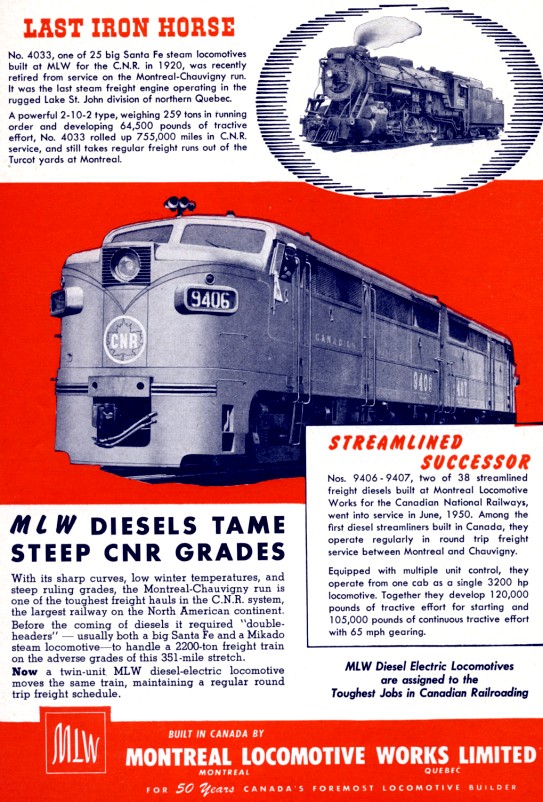
Advertisement from a 1952 Canadian National Magazine.
CNR and CPR were completely dieselized in 1960.
Gone today: MLW and Alco.
... and the federal Canadian National Railways
Canada's Nomadic North
This series of photos shows the evolution of the Inuit from traditional nomadic ways ...
to adopting more 'southern' technologies and a more 'settled' southern lifestyle.
The advantages and disadvantages of these changes are interesting to consider.
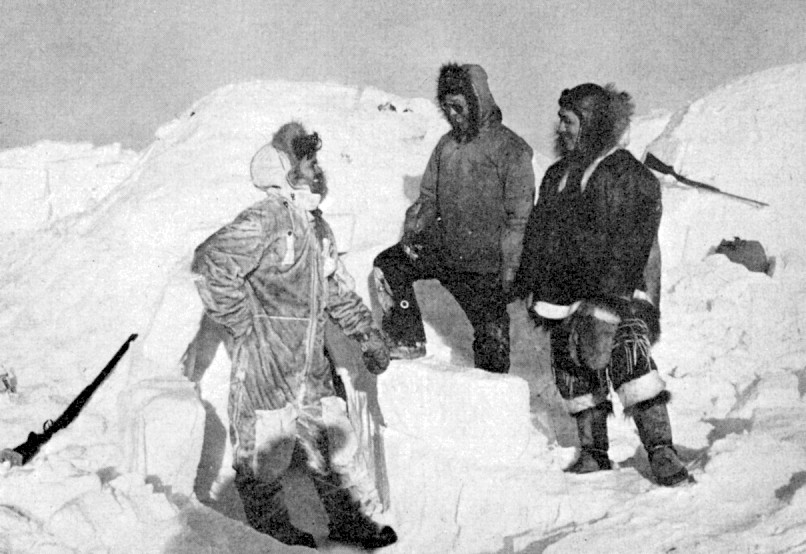
Eskimo instructors at the RCAF Survival School at Cambridge Bay, NWT, are past-masters of their subject -
how to survive in the bleak Arctic in event of a forced landing. (1957)
It looks as if the instructors have received the occasional gift of RCAF kit.
Notice the low shadow of the photographer with his large format camera.
While jets would generally fly above the weather - if the aircraft failed mechanically ...
the pilot must have had a very poor chance of surviving the following challenges ...
the physical trauma of ejecting or belly landing, blizzards, terribly cold temperatures, ice cold open water,
and extended winter darkness preventing the sighting of even the wreckage.
What was probably the pilot's best hope of survival ?
Coming down near Inuit hunters or an Inuit settlement !
Perhaps these sessions were more about 'getting to know and embrace Eskimos'.
If you read about the early polar explorers, every story is virtually the same ...
copy the 'Esquimaux' ways,
be friendly with them,
or die of scurvy and exposure in your wool uniform.
Just ask Sir John Franklin ... when he turns up ...
|
Arctic survival skills in the 21st Century? ...
Today, one estimate is that 100,000 passengers travel by commercial airlines over our polar region every day ... these industry-requested routes were approved during the last decade or so to save the airlines both travelling time and fuel. Canada's politicians and military leaders sometimes order an amphibious mission in the lower Arctic during its pleasant and un-dark, late summer ... With some bravado, and probably lots of sterno and rations, the leaders named recent exercises ... 'Operation Nanook'. It's not at all funny, but one time a few people wandered out of sight of camp, got lost, and everyone had to look for them. These exercises are intended to show we are serious about the sovereignty of our Arctic. With our military burning itself out in hot Afghanistan ... how well can Canada live up to its international responsibilities to provide search and rescue for commercial airliners in the North? 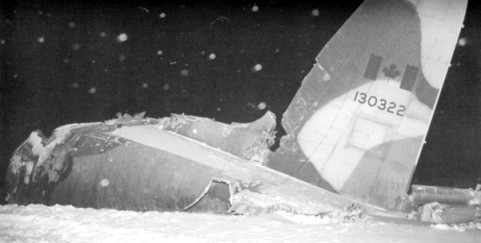 On October 30, 1991 a CF Hercules on approach crashed 10 miles short of Canadian Forces Station Alert. A blizzard hampered rescue and 13 freezing survivors were rescued 2 days later - their only shelter was this tail section. This success required inspiring and exceptional efforts by CF personnel - both the survivors and rescuers. Politicians and military leaders contributed ... inadequate equipment and a lack of preparedness for Arctic rescue missions. As a result, about 450 hours of Canadian flying time and 60 hours of US forces flying time were required to take 13 survivors 10 miles to safety. Today: Are we ready? Are we serious? |
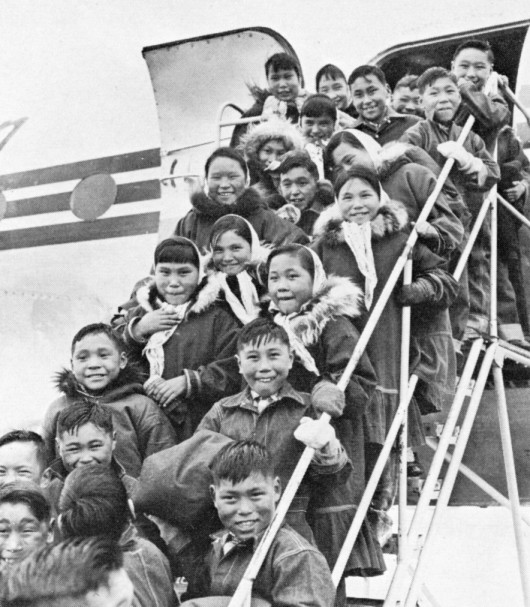
Eskimo children returning to boarding-school at Inuvik, NWT, after their summer vacation.
Their parents live a nomadic life mainly in remote hunting camps
too far away for the children to receive an education at home. (1964)
Children should have access to a general education and be literate ... this is the reasonable southern standard.
You can imagine a generational and 'environmental knowledge' gap developing
as these students gain the skills to become successful in mainstream Canadian society.
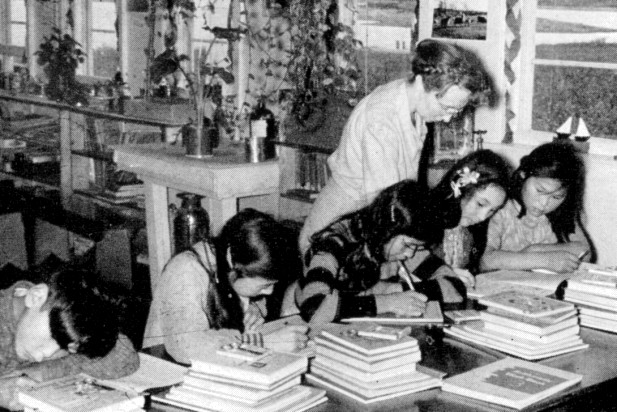
Beyond the window of this schoolroom lies the Arctic Ocean.
The Eskimo pupils have illustrated text books, crayons, and scissors.
The welfare teacher tries to impart to the children a standard of values they can carry into their adult life. (1953)
(That's what it says in the book!)
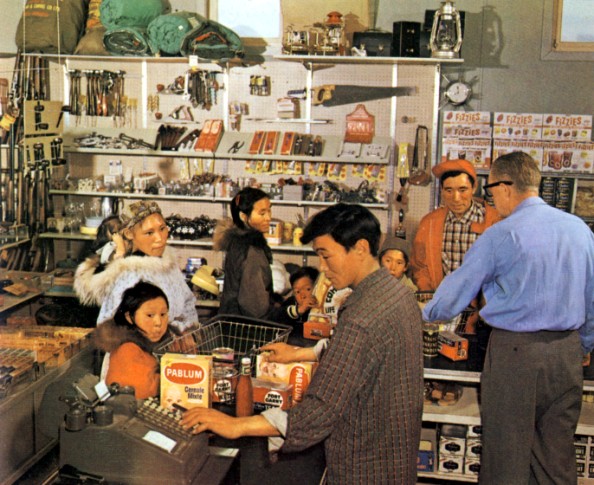
High in the Arctic, at Cambridge Bay on Victoria Island, Eskimos shop at a Hudson Bay Company store.
According to estimates (1966) Canadian Eskimos number some 13,000. (1967)
Traditional Inuit dress is still evident here, although 'southern' clothes are probably more comfortable in centrally heated buildings.
The traditional HBC goods such as metal tools, firearms and Fort Garry Tea
are being joined by factory made cigarettes, ketchup, Pablum, and 'Fizzies'.
The Hudson's Bay Company sold off its stores in northern Canada decades ago and the successor company failed.
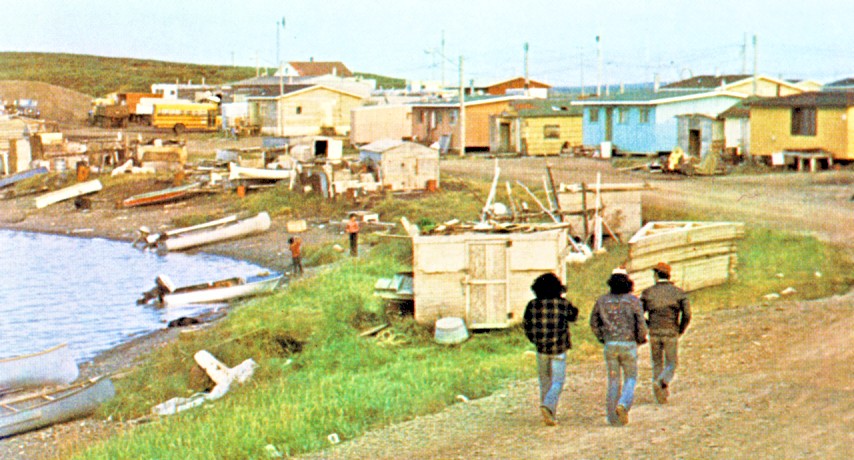
Tuktoyaktuk, NWT, at 10:30 on a July evening. (1978)
Recall that many of us dressed and groomed like the youth in the foreground in the 1970s.
A microwave communications dish, electricity, aluminum canoes and motors, a snowmobile, and pre-assembled roof trusses are visible.
These three youth are more valuable to Canada for their 'northern presence' ...
than a whole steaming jetload of cabinet ministers posing around, or choking on, teeny-tiny cubes of raw seal meat ...
from a hand-prepared,
security detail pre-tasted,
Arctic 'deli tray' in August 2009,
in support of the Newfoundland seal hunt.
(?!)
... well, there's not a lot of evidence that Newfoundlanders eat raw seal meat,
but no reasonable person objects to Inuit killing seals.
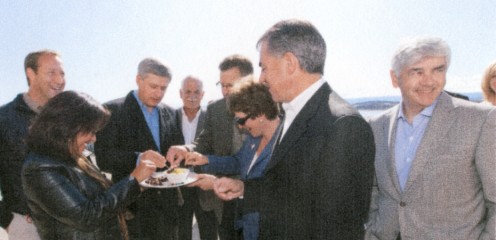
Your Canadian taxpayer dollars funded this beautiful tableau ... sucka!
Enjoy this staged PMO Arctic photo from the new Ministry of Good News.
Official MOGN transcript released with the Official Silent Video:
'Arghh! Where's me Parliamentary Secretary?!
Bring 'round me hakapik!
I have a lusty cravin' to go and club more!'
" ... just fabulous visuals and messaging, eh?
Our guy looks good ... the father and his team having a laugh!
A five point bump from this ... the True North Strong and Free, baby!
... much more pleasing to the eye than GG and her cut-open seal! ... seal heart, was it?
Head of State? ... not! ... you can't be 'with' the people,
... got to be presidential ... the camera tilts slightly up to the hero
... backlighting, clean hands, fancy toothpicks!
It's the little things that really capture Canadians' imagination!
That's what they want, and that's how they vote - don't let anyone tell you different.
Too bad we couldn't do a backdrop of Canadian flags across the horizon this time.
Blue, white and red ... would've looked perfect."
Sadly, except for the middle of the summer,
the only other time to check off sightings of rare
Great Grey-Capped Kabloona Penguins,
to hear their loon-like territorial calls: 'northPOLE northPOLE'
and to see them strutting, puffing and preening in this habitat,
is once every four years at Election Time ...
More valuable to Canada's northern sovereignty claims ...
than CF-18s thundering overhead ...
or the CF's Operation Nanook summer camp and boat rides ...
or the long-past-elections' promised northern military bases ...
and our new 'stealth' ice-breakers or patrol ships for the north ...
are the modest little arctic villages of the Inuit.


The villages (including those 3 youth) represent hundreds
or thousands of years (depending on how and what you calculating) of
continuous aboriginal habitation of the north. The Inuit 'own' the
north in an ancient and also a modern formal sense, and they aren't
planning on going anywhere else.
These Inuit ... were the 'Eskimos' ... who were declared to be 'Indians' ... so they would fall under the jurisdiction of 'The Indian Act' ... and were then 'encouraged' by the Canadian authorities to settle, and sometimes re-settle, where they were told, and forced to abandon most of their nomadic traditions. This occurred during the Cold War ... the last time we got serious about the Canadian north. The fear then was of godless Soviet bombers coming over the pole to murder us all ... or secret Soviet bases being established in the north. Current and abandoned networks of radar stations and the base at Alert are examples of how seriously the threat was perceived in the 1950s and 1960s, how much money was wasted, and how unnecessary it was to muscle the Inuit around.
Today's 'crisis' is that 'others' such as Denmark (i.e. proprietor of Greenland), Russia, and China (?) will claim 'our' north and set up 'bases' to steal our oil and the other mineral resources. Canada wants to claim this territory, so the north can be developed and 'opened up' by 'friendly' multinational corporations. In addition, except for the decades-old tradition of foreign nuclear submarines under the Canadian ice ... we don't want any other vessels skulking around in 'our north'.
If we really cared about the north and not just grabbing its oil, we would support the preservation of Inuit culture more strongly ... improve housing and living conditions and social services affecting child development ... and, 'build capacity' for the Inuit to determine how much development should take place and at what rate - not like the bitumen sands fiasco. Our efforts would, as much as possible, support an 'Inuit identity' as active owners and guardians of their land in the Canadian Arctic. The Inuit identity needs to be adapted because the land and sea are being permanently altered by climate change. Prairie farmers will not be nearly as quiet as the Inuit are today, when much of the west becomes too dry to grow grain.
Just as support for language and culture helps define and sustain Quebec ... language, culture, and pride in an identity distinctly different from mainstream Canada and some of our unimaginative 'reality TV ideals' could be supported ... with money for genuine advanced local education and training, and significant 'capacity building'. We are always hearing about our $18 billion worth of 'capacity building' efforts in Afghanistan. Why must we travel so far to help people ... and to take care of 'Canada's interests'?
Instead of continuing the unfinanced and pathetically under-equipped 'Canadian Ranger' program with their World War 2 rifles ... we could probably develop and equip joint Inuit/Canadian Forces sovereignty and rescue patrols on proper Arctic vessels and aircraft in the north. Of course ... considering our current religious devotion to markets and economics ... we'd probably have to pay the trained Inuit personnel properly to attract and retain them ... but there is no law against treating people fairly.
These Inuit ... were the 'Eskimos' ... who were declared to be 'Indians' ... so they would fall under the jurisdiction of 'The Indian Act' ... and were then 'encouraged' by the Canadian authorities to settle, and sometimes re-settle, where they were told, and forced to abandon most of their nomadic traditions. This occurred during the Cold War ... the last time we got serious about the Canadian north. The fear then was of godless Soviet bombers coming over the pole to murder us all ... or secret Soviet bases being established in the north. Current and abandoned networks of radar stations and the base at Alert are examples of how seriously the threat was perceived in the 1950s and 1960s, how much money was wasted, and how unnecessary it was to muscle the Inuit around.
Today's 'crisis' is that 'others' such as Denmark (i.e. proprietor of Greenland), Russia, and China (?) will claim 'our' north and set up 'bases' to steal our oil and the other mineral resources. Canada wants to claim this territory, so the north can be developed and 'opened up' by 'friendly' multinational corporations. In addition, except for the decades-old tradition of foreign nuclear submarines under the Canadian ice ... we don't want any other vessels skulking around in 'our north'.
If we really cared about the north and not just grabbing its oil, we would support the preservation of Inuit culture more strongly ... improve housing and living conditions and social services affecting child development ... and, 'build capacity' for the Inuit to determine how much development should take place and at what rate - not like the bitumen sands fiasco. Our efforts would, as much as possible, support an 'Inuit identity' as active owners and guardians of their land in the Canadian Arctic. The Inuit identity needs to be adapted because the land and sea are being permanently altered by climate change. Prairie farmers will not be nearly as quiet as the Inuit are today, when much of the west becomes too dry to grow grain.
Just as support for language and culture helps define and sustain Quebec ... language, culture, and pride in an identity distinctly different from mainstream Canada and some of our unimaginative 'reality TV ideals' could be supported ... with money for genuine advanced local education and training, and significant 'capacity building'. We are always hearing about our $18 billion worth of 'capacity building' efforts in Afghanistan. Why must we travel so far to help people ... and to take care of 'Canada's interests'?
Instead of continuing the unfinanced and pathetically under-equipped 'Canadian Ranger' program with their World War 2 rifles ... we could probably develop and equip joint Inuit/Canadian Forces sovereignty and rescue patrols on proper Arctic vessels and aircraft in the north. Of course ... considering our current religious devotion to markets and economics ... we'd probably have to pay the trained Inuit personnel properly to attract and retain them ... but there is no law against treating people fairly.
And there never was such a law ... in spite of what we read in Arctic history.
Beyond those specifics,
if we do train and mentor the Afghanistan civil forces and government functionaries,
why do we not train and mentor the Inuit ... then get out of their way?
Beyond those specifics,
if we do train and mentor the Afghanistan civil forces and government functionaries,
why do we not train and mentor the Inuit ... then get out of their way?
None of this will ever happen ... but what might be accomplished if
the imagination of the citizens of Canada was captured by bigger things ...
than the daily artifice of the Cabinet's taxpayer-funded 'Public Perception Theatre'.
the imagination of the citizens of Canada was captured by bigger things ...
than the daily artifice of the Cabinet's taxpayer-funded 'Public Perception Theatre'.

Near Churchill, Manitoba June 1987
Photo by S. Gagnon
During a conducted tour of
Churchill, we were taken to a remote area of shoreline where a group
of 'reborn' sled
dogs was tethered. They were arranged in a line, just out of reach of each
other, but close enough to attack from both sides and thus frighten away any
hungry polar bears. By the late 1980s, sled dogs ... and their centuries
of accumulated genetics ... had largely disappeared. Snowmobiles don't
need to be fed all year ... and fast, shiny, new snowmobiles are
objects of which to be proud.
However, snowmobiles have their limitations. They don't breed new snowmobiles. In the event of breakdown without spare parts, the snowmobile is entirely useless. With sled dogs, the traveller always has multiple 'power units'. If stranded in a blizzard and short on food, these 'power units' are individually edible ... unlike a snowmobile.
However, snowmobiles have their limitations. They don't breed new snowmobiles. In the event of breakdown without spare parts, the snowmobile is entirely useless. With sled dogs, the traveller always has multiple 'power units'. If stranded in a blizzard and short on food, these 'power units' are individually edible ... unlike a snowmobile.
It was somewhat shocking to realize the permanent consequences of the nearly
universal decision to drop sled dogs in favour of snowmobile technology.
By the same token, it was encouraging that someone realized that sled dog genetics were being lost in just a couple of decades ... before it was too late.
By the same token, it was encouraging that someone realized that sled dog genetics were being lost in just a couple of decades ... before it was too late.
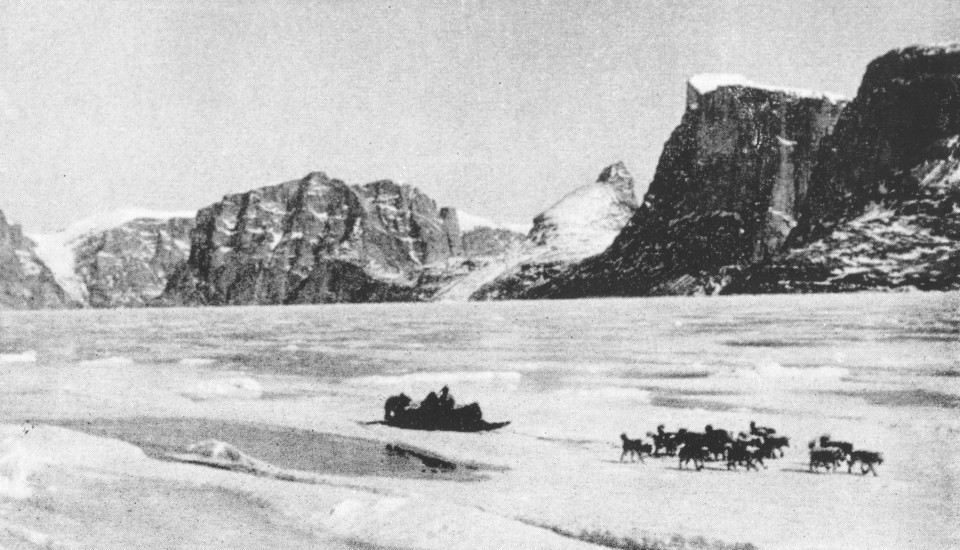
Travelling by dog-team on a fiord on the northeast coast of Baffin Island in June.
In this mountainous part of the island, peaks rise sharply to between 5000 and 6000 feet. (circa 1950)
End of Canada's Nomadic North
Open Outcry Markets and Exchanges
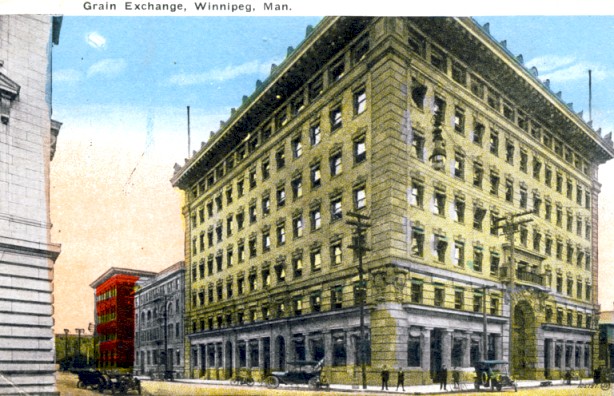
Winnipeg's Grain Exchange Building ... a postcard photo taken on a Sunday morning in the late 1920s?
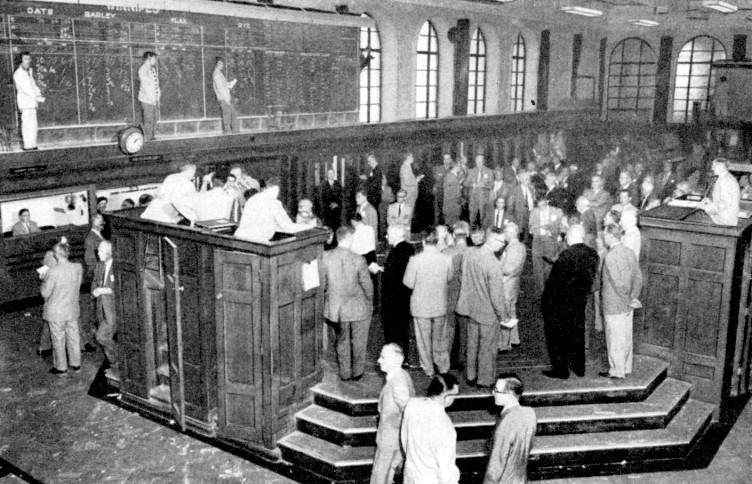
The trading floor of the Winnipeg Grain Exchange,
one of the most important trading centres of its kind in the world. (1960)
You will notice the clerks who record the most recent market prices on the blackboard.
The stairs up to one of the 'posts' can be be seen behind the open door.
* * *
In an open outcry market the buyers and sellers meet face-to-face at a 'market'.
A quantity of a commodity or a security is is offered for sale at a given 'offer price'.
Usually a lower 'bid price' for a given quantity is made by a potential buyer(s).
The 'market price' for the desired quantity is based on supply and demand ...
usually meeting somewhere in the middle between the original offer and original bid prices.
* * *
Around the world and throughout the year ...
the sun never sets on ripening grain.
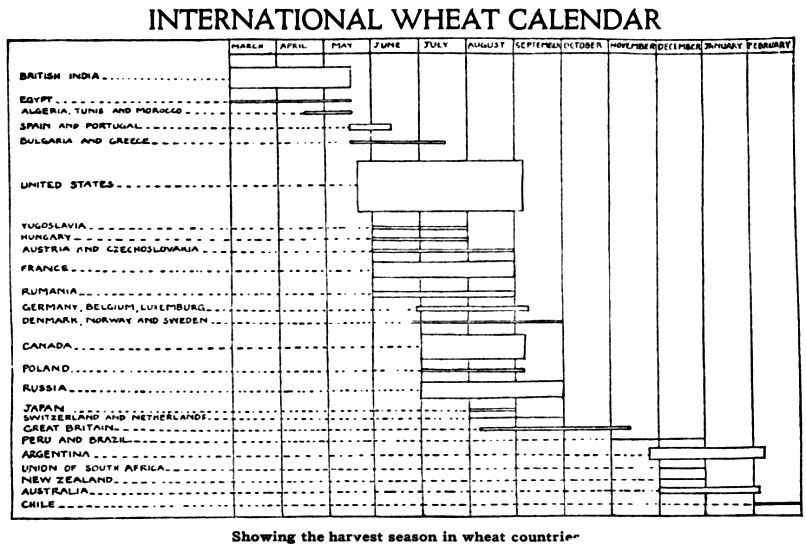
From a 1933 book on grain trading and speculation.
The vertical dimension of the bars must represent the relative size of the harvest.
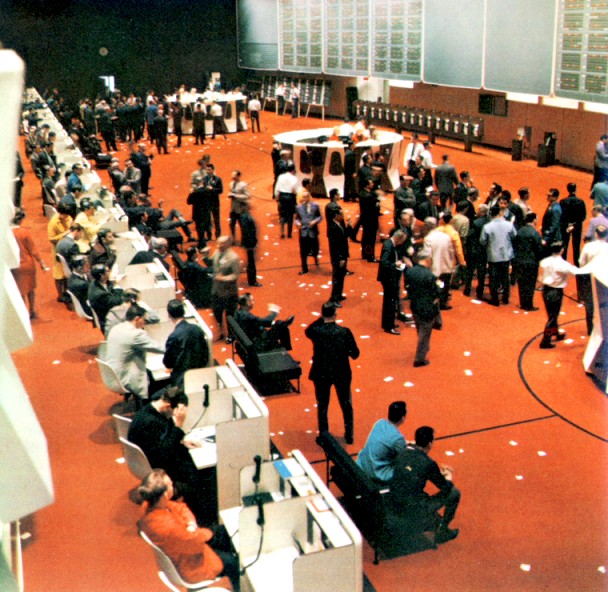
The floor of the Montreal and Canadian Stock Exchanges at Place Victoria, in the early moments of business. (1967)
An electronic price board has replaced the clerks and their chalk in this market.
The white desks with telephones and clerks belong to the various securities firms.
Hand signals were used in open outcry markets to quickly communicate stocks, quantities and prices ...
from the telephone clerks to the floor traders of the same firm ...
when very quick arbitrage transactions were ordered from the securities firms' offices.
Way back in 1999, when I took the courses to work as a 'stockbroker',
we had to know where the 5 Canadian stock and commodity exchanges were.
Toronto still had a trading floor with a public visitors' gallery into the 1990s.
Today there is really only one 'stock exchange' left in Canada ... at Toronto.
Instead of networks of telephones leading to face-to-face traders.
Firms dealing in securities connect their trading systems to the computer servers of the Stock Exchange.
Computer programs now match up most buyers and sellers.
The unique culture, competition, and camaraderie of the clerks and floor traders is gone.
Newsprint and Ink
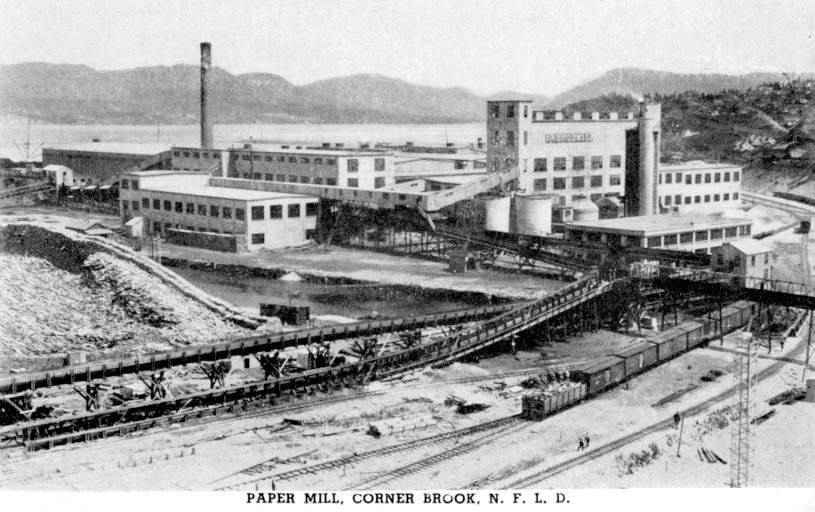
A frequently visited location on this website is Corner Brook, Newfoundland.
More about its story and interesting history can be found in the Newfoundland section at the sitemap.
In this photo, the Newfoundland Railway brings pulp logs to the back door of the mill.

Newsprint going aboard a freighter at Corner Brook, N'f'ld. Newsprint paper is Canada's leading export.
In 1949, 4,789,000 tons were exported, 91 p.c. of which went to the United States. (1951)
Out of the mill's front door to the world, come the complete rolls of newsprint.
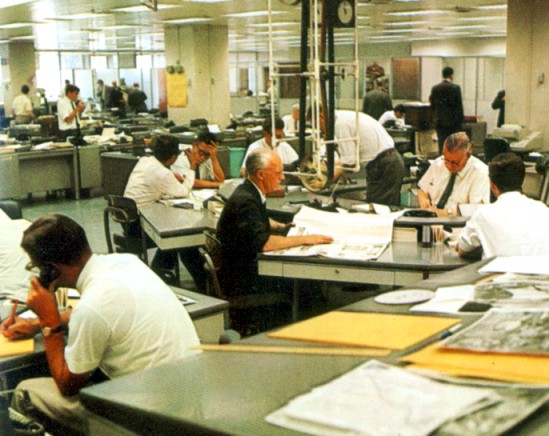
The news room of a daily newspaper is a sensitive and busy centre.
In this typical scene at the Montreal Star reporters and editors prepare copy. (1967)
At the lower left corner, you can see part of an old typewriter for writing draft 'copy' for editorial review.
At the right margin above the man's head, you can see an old teletype machine.
A 'wire service' such as Canadian Press would have reporters across the country gathering news and writing their reports.
The completed, editor-checked stories would be typed into a CP teletype machine for national distribution.
Across Canada, the stories would hammer themselves out at news offices subscribing to the CP wire.
The bell of the teletype would ring as a new story began to print (see next).
The Star's editors could select and pay for wire service stories if they were published in the Star.
Knowlton Nash in 'History on the Run'
wrote about his experiences with the teletype as a 19 year old night
editor with the British United Press at Toronto in 1947 ...
" ... it seemed like the centre of
the world to me with reports coming in from across the country and from
UP correspondents in Tokyo, Berlin, London, Cairo, and Moscow (where the
UP correspondent was a young fellow named Walter Cronkite). Twenty-four
hours a day the teletype clattered and ran with 'URGENTS' which were
given three bells, 'BULLETINS' which got five bells, and the very rare
'FLASHES' at ten bells."
* * *
"... UPI got the story first, sending the dreadful news clattering from tickers across the world. "FLASH ... KENNEDY WOUNDED, PERHAPS FATALLY, BY ASSASSIN'S BULLET... "
UPI's Merriman Smith, the dean of the White House correspondents, was
in the car carrying news agency correspondents; it always travelled
immediately behind the presidential car. Smitty grabbed the car phone
and got out the first FLASH on the Kennedy shooting and then hung onto
the phone to keep it away from his AP competitor by asking the operator
at the other end to read back what he'd dictated, an old news agency
trick."

More than 4,000,000 newspapers are printed every day in Canada.
Advertising is news, too, and many advertisers use only this means of reaching customers. (1960)
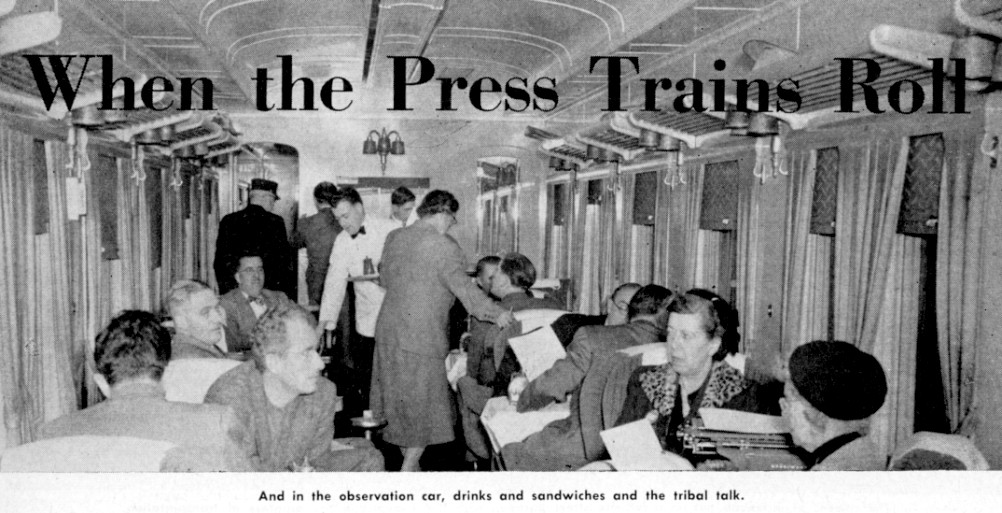
from a 1953 Canadian National Magazine
|
A 'pilot train' is mentioned below in the context
of the cross-Canada Royal Tour of 1939.
The Pilot Train would carry
the press and any officials who wanted to arrive early to set up for the
next royal stop ... arriving 30 minutes in advance of the Royal Train.
All other traffic was kept off the railway while the Pilot and Royal
Trains were running. Normally passing track switches would be locked for
safety. However, to provide additional protection for these movements,
locked track switches were also spiked in position for travel via the main line
to make it more difficult for any error or sabotage to occur.
Calamities would be more likely to befall the Pilot Train, containing the press, as it led the way for the Royal Train.
|
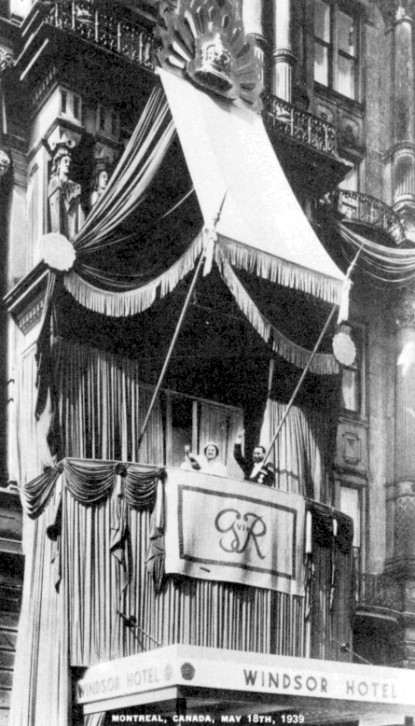
Postcard: "Be sure to use Canadian stamps"
King George VI and Queen Elizabeth at Montreal in May 1939.
The King and future Queen Mother had just arrived in Canada at this point.
They would travel about 6000 miles by rail before departing a month later.
Some text from
'When the Press Trains Roll'
Canadian National Magazine 1953
[in 1949] " ... The election
trains were rolling then, bombastic safaris on the sweet scent of
political power, the leaders and their entourage making up one part,
the press and their entourage immediately behind, the two blending into
one 20th century phenomenon roaring through the country from coast to
coast, spewing out words in multitudes on the issues of the day."
* * *"The man who remembers more
about press cars and trains than anyone else is, of course, Walter S
Thompson, the long-time, now-retired director of public relations for
the CNR. If press trains have a Canadian father, Walter is it. He
traces them back to the years just before the First World War when new
lines were being opened up in the near northland and reporters were
taken along to spell out the wonders of the day.
From there they grew into an infrequent, episodic pattern that first bloomed to luxuriant proportions for the royal tour of 1939. That tour and its 1951 successor, says Walter Thompson, produced what were probably the daddies of all press trains. No country, he says has ever really matched them.
In 1939, 58 correspondents were accredited for the whole tour and local reinforcements continually streamed aboard. The CNT [Canadian National Telegraphs] alone filed 1,500,000 words to every corner of the globe, often up to 40,000 of them in one gulp. The so-called pilot train became a press workshop on wheels.
Press trains they were called but the word has become a broad one. There was the daily and weekly press, the magazines, radio, photographers, newsreel cameramen and in 1951 the first appearance of TV. There were functionaries in variety to service this cavalcade. Across the land they went, into tumultuous cities and gawking towns, through all the ribboned rubber-necked fiesta and all the emotional fervour, recording it in print and pictures and in the spoken word, pouring out words until they reached a mountain, reaching nearer and nearer the bottom of the reservoir of adjectives, seeking eternally for another angle in ceremony and tumult that was always the same and yet always the framework for variety.
Montreal ... Quebec ... Ottawa ... Brockville and on through Eastern Ontario, into Toronto. They wrote all day and night. Canadians writing, Americans, Britons, Australians, Frenchmen. Typewriters gabbling down the long compartmented corridors. And in the observation car, drinks sandwiches and the tribal talk, the soft-boiled, skeptical talk, the polished talk of the cosmopolites.
Down the corridors the names are on the doors. Greg Clark, Ross Munro, Norman McLeod, John Fisher, names from the big papers and the news agencies, from foreign lands, badges of an assembled clan.
It's like that on the election train, too, only perhaps slightly less so. Fewer people. Press cars instead of press trains. Nearly all Canadians, making up a more intimate and jolly company. But there is the same atmosphere, the same levity and clatter, the same talk."
The Montreal Star and the press trains are gone as well.From there they grew into an infrequent, episodic pattern that first bloomed to luxuriant proportions for the royal tour of 1939. That tour and its 1951 successor, says Walter Thompson, produced what were probably the daddies of all press trains. No country, he says has ever really matched them.
In 1939, 58 correspondents were accredited for the whole tour and local reinforcements continually streamed aboard. The CNT [Canadian National Telegraphs] alone filed 1,500,000 words to every corner of the globe, often up to 40,000 of them in one gulp. The so-called pilot train became a press workshop on wheels.
Press trains they were called but the word has become a broad one. There was the daily and weekly press, the magazines, radio, photographers, newsreel cameramen and in 1951 the first appearance of TV. There were functionaries in variety to service this cavalcade. Across the land they went, into tumultuous cities and gawking towns, through all the ribboned rubber-necked fiesta and all the emotional fervour, recording it in print and pictures and in the spoken word, pouring out words until they reached a mountain, reaching nearer and nearer the bottom of the reservoir of adjectives, seeking eternally for another angle in ceremony and tumult that was always the same and yet always the framework for variety.
Montreal ... Quebec ... Ottawa ... Brockville and on through Eastern Ontario, into Toronto. They wrote all day and night. Canadians writing, Americans, Britons, Australians, Frenchmen. Typewriters gabbling down the long compartmented corridors. And in the observation car, drinks sandwiches and the tribal talk, the soft-boiled, skeptical talk, the polished talk of the cosmopolites.
Down the corridors the names are on the doors. Greg Clark, Ross Munro, Norman McLeod, John Fisher, names from the big papers and the news agencies, from foreign lands, badges of an assembled clan.
It's like that on the election train, too, only perhaps slightly less so. Fewer people. Press cars instead of press trains. Nearly all Canadians, making up a more intimate and jolly company. But there is the same atmosphere, the same levity and clatter, the same talk."
Back to Sitemap